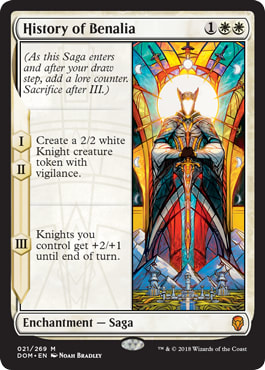Sometimes, Wizards of the Coast wants to tell a story on a single Magic card. They do this by having the card perform some sort of effect that varies from one turn to the next. It's difficult to pull off this kind of flavor on a one-time card, such as an Instant or Sorcery. Creatures and Artifacts are permanent, but having their abilities vary from one turn to the next may not see intuitive.
To overcome these barriers, Wizards created a new enchantment subtype, called Sagas, introduced in the original Dominaria set.
The way these Sagas work is fairly elegant in design. History of Benalia, the example above, enters the battlefield with a lore counter on it, triggering chapter I (creating a 2/2 White Knight creature token with vigilance). Then after your next two draw steps, you add another counter--the second one repeats the 2/2 token creation and the third one triggers a +2/+1 boost to all your knights for the turn. After the final chapter is enacted, the Saga is sacrificed.
Over the years, Wizards has toyed with many different flavors of Sagas--variable number of chapters, all kinds of effects, creatures that transform into Sagas, Sagas that transform into creatures (especially in Kamigawa: Neon Dynasty), and even an Enchantment Land that's also a Saga!
Just when you thought WOTC couldn't find another way to innovate with Sagas, they came up with a new and exciting idea for the Final Fantasy set.
Creature Sagas
Cool Stuff Inc.'s writing team has covered various subsets of Sagas over the years, and with the advent of these new creature Sagas, it's time to revisit them yet again. This time, their play pattern will be quite different relative to their predecessors. Let's look at an example: Summon: Shiva.
Let's unpack this card line by line. For five mana, you're casting this Enchantment Creature - Saga Elemental, meaning it will enter with a lore counter on it, activating chapter I. Chapter I taps and stuns an opponent's creature. Chapter II is a repeat, meaning you'll get to stun another creature on your next turn. After the third lore counter is added, you draw a card for each tapped creature your opponents control and the card is sacrificed.
It all sounds similar to your standard Dominaria / Dominaria United / Kaldheim / etc. Saga, right? It is, except for one key difference--while its on the battlefield, this Saga is also a 4/5 creature! Thus, you not only have all the chapters taking place turn by turn, but you also have a formidable creature with which you can attack, block, or target, while its in play.
It sounds busted, right? This is a great deal of power and abilities for just five mana. And it would be absolutely broken...if the creature stuck around permanently.
You see, regardless of whether it's a Saga, Saga Land, or Saga Creature, the card is still sacrificed once that final chapter is activated. That means this creature is going to head to the graveyard after the fourth lore counter is added pretty much no matter what. As you can imagine, this has profound implications on how these creatures will play out throughout a game of Magic. I suspect you'll see this manifest itself especially often in Limited gameplay.
The Implications of Creature Sagas
Creatures, especially 4/5 creatures like Summon: Shiva above, are meant to enter combat. Better yet, how about Summon: Titan, a threatening 7/7 creature Saga with trample and reach!
Summon: Titan doesn't not only hit hard, but also generates mana advantage and pumps another creature before wearing out its welcome. Chapter I is mostly harmless, milling five cards (though there could always be some graveyard synergies to exploit). Chapter II is where you get paid off for milling cards because you can return all lands in your graveyard to the battlefield tapped. Then you get to the real payoff, Chapter III, which gives another creature you control +X/+X and trample until end of turn, where X is the number of lands you control!
This will consistently pump one of your creatures +6/+6 or even more depending on the turn you cast Summon: Titan. In other words, this creature Saga can end a game in a hurry.
A hurry, that is, if it sticks around. You're going to want to attack or block with this powerful creature. Trample and reach don't do anything if the creature never enters combat. Does that mean you should? It will depend on so many factors!
For example, if your opponent has a formidable board of creatures, and attacks you, should you block with Summon: Titan? A 7/7 is tough to kill, but what if your opponent has untapped lands available to potentially play a combat trick? If Summon: Titan dies in combat, you won't get the benefits of chapters II and III. You can't add a second and third lore counter to a Saga that's in the graveyard. Thus, despite having reach, you may choose not to block the turn Summon: Kujata enters the battlefield because you want to wait for the second chapter's effect to occur.
The same goes for attacking. Granted, if you do the math you'll quickly realize that a creature Saga with three chapters can only attack once in a normal game of Magic.
Summon: Primal Odin is another rare Saga enchantment creature with three chapters. When you cast the card, you'll get chapter I's effect right away, but the creature will still have summoning sickness. Therefore, you'll be crossing your fingers hoping this creature lives until your next turn, when you reap the benefit of chapter II.
That's when you have the big combat decision--after chapter II's resolution, during combat, you'll have your one chance to attack with this creature. The turn before it has summoning sickness. The turn after the creature must be sacrificed immediately after you place the third lore counter on it. Therefore, the number of turns you can attack with most these Final Fantasy Saga creatures is N-2, where N is the number of chapters on the Saga.
Is it worth attacking? That will depend on how likely the creature will survive combat, combined with how important the subsequent chapters' effects will be on the game. Summon: Primal Odin is a special case because its second chapter ability is so powerful. You have a chance of straight-up winning the game if Summon: Primal Odin gets through.
If your opponent has sufficient blockers, however, you may consider other factors before deciding to attack. If you are likely to die the next turn unless you draw a key removal spell, you may choose not to attack to ensure you draw those extra cards. Alternatively, if you're at two life after removing the second lore counter, you may choose to attack to try and force a trade, knowing you're dead to the creatures third chapter next turn.
Whether or not you choose to attack and block with a Saga creature is going to vary heavily on the game state and the Saga's unrealized chapters. This will make for some exciting and intense gameplay. Decisions, decisions...
Do These Count as Creatures?
Before you even cast these Saga creatures, you'll have some important deck building considerations when drafting Final Fantasy. Namely, do you include these cards as part of your overall creature count?
Typically, a Limited deck wants to contain a certain threshold of creatures (depending on the strategy) because attacking for damage is the most common path to victory in the format. If your deck has only a handful of creatures that can attack for damage, you'll have a difficult time reducing your opponent's life total to zero.
These Saga creatures are technically creatures, but they only stick around for a couple turns and often can only attack once or twice. Are they powerful enough to get the job done? Chances are if you built a deck with 16 creatures and 14 of them were creature Sagas, you'd never have enough on the battlefield at once to profitably attack consistently.
Granted, some of these Final Fantasy creature Sagas also make more creatures, such as Summon: Knights of Round. Still, would you count this as a creature in your deck? You can't cast it until you get to eight mana, and then it's only a 3/3. Creating a 2/2 Knight is nice, but you need to wait a few turns before you get the big payoff. I'm not sure if this will play out well--we often want our eight mana spells to win us the game. While Summon: Knights of Round may get you there eventually, the payoff isn't until chapter V, and if you're behind all this time, you won't live long enough to give all your knights indestructible counters.
Or how about Summon: Choco/Mog, which is an uncommon and will therefore show up far more frequently in Limited play.
A White three-mana 3/3 creature is OK, but the real power is when playing this creature in a go-wide strategy. If you're not trying to go wide and are counting on this creature to be your three-drop, keep in mind this will not stick around for very long. Should you just attack with it to try and trade it off before it gets sacrificed? Should you try to block with it if you're not reaping benefits from each chapter? Does Summon: Choco/Mog count as a creature in your deck's creature count?
These are all important questions to answer, but we probably won't know exactly how things will play out until Final Fantasy hits Arena.
Wrapping It Up
Of all the cards in Final Fantasy, I'm most excited to see how these creature Sagas play out. I loved the Sagas from Kamigawa: Neon Dynasty that flipped into creatures for their final chapter. While those creatures stuck around permanently, Final Fantasy's Saga creatures will only be available to attack and block for a turn or two.
How good will that actually be? It's really hard for me to predict--like most things nowadays, it'll depend on the speed of the format, the number of creature Sagas you include in your deck, and the gameplay itself.
Lastly, I want to give honorable mention to the creatures that can transform into Sagas in Final Fantasy, such as Terra, Magical Adept (frontrunner for my favorite art in the set).
Terra starts as a three-mana 4/2 creature. You can activate its Trance ability for 4RG to exile Terra and then return it to the battlefield transformed, giving you Esper Terra, a 6/6 flying creature Saga!
Unlike most Final Fantasy creature Sagas, Esper Terra doesn't get sacrificed after its final lore counter is added. Instead, this time you do exile Esper Terra and then transform it back to Terra, Magical Adept. Terra is one Saga that will stick around--you should definitely count this as a creature in your Limited deck. The question of whether or not you want to attack or block with her, however, remains unclear.

































